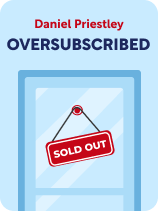

This article is an excerpt from the Shortform book guide to "Oversubscribed" by Daniel Priestley. Shortform has the world's best summaries and analyses of books you should be reading.
Like this article? Sign up for a free trial here.
How do you get enough people talking about your business to make it profitable? What if you saw yourself as a campaign manager instead of a salesperson?
Daniel Priestley discusses why and how you should build an extreme level of demand for your products before starting to sell them. He then provides the steps for a successful marketing campaign: determine your supply, prime the market, reach critical mass, make the sale, and keep people talking.
Keep reading to learn how to create a successful marketing campaign with these five steps.
How to Create a Successful Marketing Campaign
Priestley believes you should build more demand than you can meet, and he argues that word-of-mouth is the most effective way to do that. Then, he shares his advice on how to create a successful marketing campaign.
Priestley says that running a successful business—one with more demand than supply—requires you to be a campaign manager rather than a salesperson. In other words, he suggests that you connect with large numbers of people at once through special events and mailing lists rather than trying to draw in one customer at a time like a hawker on the street.
In his book, Priestley organizes his method for running a successful marketing campaign into five phases. Here, we’ve organized Priestley’s method into five steps; the first three steps correspond with Priestley’s first three phases. We’ve broken Priestley’s fourth phase (“Sales Follow-Through”) into Steps 4 and 5 to distinguish between selling products (Step 4) and delivering them (Step 5). We’ve also incorporated ideas from Priestley’s fifth phase (“Celebrate and Innovate”) into Step 5.
Step 1: Determine Your Supply
Before you even begin your campaign, Priestley says that you need to figure out exactly how much supply you have—in other words, how many customers you can serve and how often. Only once you know your business’s capacity can you start making plans to exceed it.
Your answer to this question will largely depend on your business model. For example, if you’re selling handmade clothing, you might only be able to fill a couple of orders each month. On the other hand, if you’re opening a family restaurant, you can serve dozens of customers every day.
(Shortform note: When determining your supply (in other words, your business capacity) make sure you’re taking human limitations into account. For instance, if your planned capacity requires you or your employees to work 60 hours a week, you’re probably being overambitious; you’ll soon find your employees suffering from overwork and fatigue. On a similar note, don’t plan your capacity around everything going perfectly—you’re bound to encounter problems and mistakes, so make sure you’ve left yourself a comfortable buffer rather than assuming you’ll reach your maximum possible production every day.)
Step 2: Prime the Market
Now that you know what you’re selling and how much of it you have, you need to know who you’re selling to. What kind of people would you enjoy working with? Would those people want what you’re selling? Can they pay your prices?
For example, maybe you’re offering a rideshare service that would make it easier for low-income families to get around crowded urban areas. However, if you have to charge more than those families can afford, that won’t be a good market for you—you might be better off branding it as a luxury service and targeting a higher income bracket instead.
(Shortform note: When selecting your target market, it’s crucial to research that market instead of making assumptions about it. For example, demographics like the average age and gender of your target market can be just as important as that market’s average income—every piece of information you collect helps you understand what your future customers want and need and how much they’re willing to pay for a product.)
Once you know who your target audience is, let those people know what you’re selling and get them interested in buying from you. Communication is the key here: Priestley says you need to send very clear messages about what you’re offering and why people should want it, as well as providing a way for people to clearly express their interest.
Priestley suggests sending regular newsletters with information about your products and services, upcoming sales and special events, and what you’re working on next. This will help keep your company on people’s minds, and people who sign up for your newsletter are indicating interest in your company.
Aside from a general newsletter, you might offer customers subscriptions for updates about specific products. This maintains the relationship between your business and your customers and also provides a way for customers to show you what they’re interested in—the products that get the most subscriptions are the ones that you should focus on.
(Shortform note: In addition to educating people about your company and your products and helping you gauge people’s interest, newsletters and mailing list subscriptions can help foster a sense of community between your company and your customers—remember the importance of building brand loyalty, which we discussed earlier. For example, you can highlight individual employees, share and celebrate your successes with your customers, and publish personal statements to apologize for missteps or clear up misunderstandings.)
Step 3: Reach Critical Mass
As previously noted, the core concept of Oversubscribed is that you should have more demand than you can fulfill; now Priestley clarifies exactly how much interest you should have in your products before you start selling.
Priestley sets three different goals and says that, if you’re meeting at least one of them, you’re in good shape to bring your product to market.
1) If people express strong interest, sell when there’s five times as much engagement as there is product. Strong interest means a nearly-guaranteed sale, such as preorders and people putting down deposits for your product. So, for example, if you can sell to 10 people at a time and you have 50 preorders, you’ve met this goal.
2) If people express moderate interest, sell when there’s 10 times as much engagement as there is product. Moderate interest means that people have gone out of their way to learn about your product and express interest in buying it, such as going to an event or signing up for a mailing list. Again, if you can handle 10 customers at a time, you’ll meet this goal once you get 100 people at this level of engagement.
3) If people express mild interest, sell when there’s 100 times as much engagement as there is product. Mild interest suggests that people are curious about your product but not yet invested in it. People at this level of engagement might click on an ad, watch a short video, or download information from your company’s website. If you’re looking to sell to 10 customers at once, you’ll want at least 1,000 people at this level of engagement before moving to the next step of your campaign—making the sale.
| Save Time and Trouble With Crowdfunding It can be hard to gauge exactly how much interest there is in a product, which may make it hard to apply Priestley’s advice on determining when to start selling. Fortunately, crowdfunding sites like Kickstarter can help you manage this step and the next one (making the sale) simultaneously. Instead of advertising a product, building people’s interest in it, then moving on to sales, you can advertise, know exactly how many people are interested in your product, and make sales at the same time with a preorder campaign. As Salim Ismail explains in Exponential Organizations, crowdfunding has other benefits too: Most notably, seeing how many people fund or preorder your product provides valuable market research about what people are (or aren’t) interested in. Also, if your campaign doesn’t perform as well as you hoped, you can cancel it at minimal cost to yourself—you’re only losing the money you spent on advertising—and no cost to your customers, which will help them to keep a positive view of your company. |
Step 4: Make the Sale
Once you’ve got enough engagement to be confident that your product will succeed, it’s time to actually make the sale. This should be the most straightforward step of the whole process—people are already interested in your company and educated about your product. So, at this point, a simple conversation with the customer is all you need.
Despite this step’s simplicity, Priestley says that this is where a lot of new companies stumble. People often feel uncomfortable asking for customers’ personal information and money, so they waste time with small talk and fail to actually close the deal.
Just remember: If you’re having a sales conversation with someone, it’s because that person has already expressed interest in buying your product. In other words, you and the customer both know that the purpose of the conversation is to collect information and money, so there’s no reason to feel uncomfortable about it—you can get through this step easily and confidently.
Step 5: Keep People Talking
Your work isn’t done just because you’ve made the sales. When fulfilling orders, Priestley suggests giving your customers more than you promised. Exceeding your clients’ expectations will excite them and get them talking about your company, making it so the end of one marketing campaign is also the start of the next one. For example, you might include a free sample of another product you sell or send your customers thank-you notes and small gifts.
Note that exceeding expectations doesn’t mean you have to work harder or strain your resources; you can accomplish the same thing by setting customer expectations a little lower at the start. For instance, if you’re prepared to deliver your product in one month, you might tell your clients that they’ll have it in two months—they’ll be very happy when they get it earlier than expected.
Finally, when you start your next advertising campaign, make sure to broadcast how successful your business already is. Remember: Demand breeds demand, and people want what’s hard to get.
Exercise: Plan Your Marketing Campaign
Now that you know Daniel Priestley’s strategy for building more demand than you can meet, think about how you might put it into practice to sell a product or service of your own.
- What product or service would you like to sell?
- Who is your target market? For example, you might want to target a certain geographical area, a certain income bracket, or specific personality traits. (Remember, you’re looking for people whom you’re interested in working with, who would want to buy what you’re selling, and who can afford to pay your prices.)
- How will you advertise to that market? How will you get them talking about your company? (Remember, you need a way to stand out from the competition—create a unique product or something that’s cheaper or more convenient than similar offerings currently on the market.)
- How might you overdeliver on your promises to your customers? (For example, you might include a free sample of another product or offer a discount on their next payment for a service.)

———End of Preview———
Like what you just read? Read the rest of the world's best book summary and analysis of Daniel Priestley's "Oversubscribed" at Shortform.
Here's what you'll find in our full Oversubscribed summary:
- Why you should build demand for your product before you even release it
- How to run a successful marketing campaign
- Why word-of-mouth advertising is more effective than mass marketing






